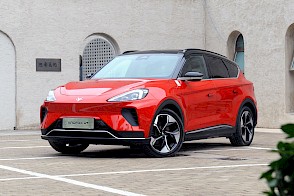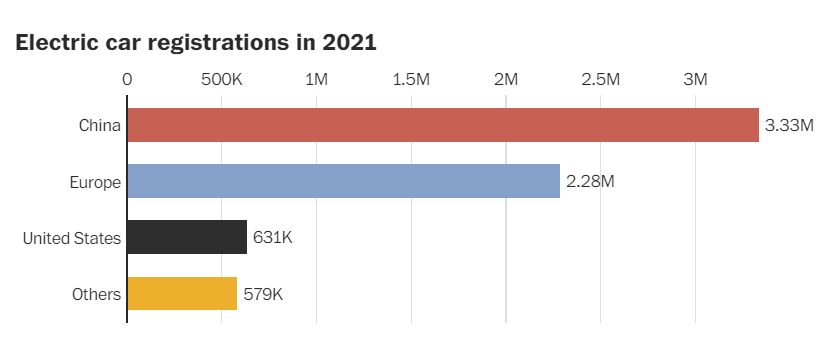China's electric cars buoyed by state support poised to sweep the world
 When Daniel Zhu bought his first electric car earlier this year, the primary motivation wasn’t environmental. It was practical.
When Daniel Zhu bought his first electric car earlier this year, the primary motivation wasn’t environmental. It was practical.
Getting a license plate for a gasoline car in Beijing was nearly impossible. What’s more, Arcfox, a Chinese brand launched by the state-owned BAIC Group in 2020 as a potential Tesla challenger, was offering a deal that knocked several thousand dollars off the price tag, bringing the battery-powered sedan down to about $34,000.
And for daily use, electricity was cheaper than gas. “If it were not for the restrictions on license plates, most of my friends would have preferred a gasoline car, but for those who already have a car, they would consider an EV because charging costs less,” the 28-year-old factory manager said.
This year, about a quarter of the cars bought in the world’s largest auto market have been battery-powered or plug-in hybrids. By year’s end, that will be about 6 million vehicles. No other country comes close.


China’s rise as an electric vehicle powerhouse has been fueled by generous government support as well as fierce domestic competition, pushing prices lower and demand up. Not only are electric options in China now cheaper on average than gasoline cars but they are also more affordable than comparable vehicles sold in Europe and North America, according to research firm JATO Dynamics.
Analysts increasingly see Chinese automakers leading the industry’s electric revolution not just in China but globally, as Chinese offerings become available overseas. From a planetary viewpoint, the arrival of affordable Chinese electric vehicles is a win for global efforts to prevent the worst consequences of climate change. It is one area where the world’s largest emitter is ahead of schedule for its Paris Agreement commitments to reduce greenhouse gas output.
It’s also a victory for industrial planners in Beijing who have been focused on forging a world-leading automotive brand for decades. Chinese manufacturers like Nio and BYD are now often spoken of as Tesla challengers.
But the race is far from over. They remain among more than a dozen manufacturers selling electric vehicles at significant volumes in China today. Many face bankruptcy brought on by overcapacity and razor-thin profit margins. The story of the venerable BAIC Group is a good example of this blend of intense competition and state support.
The company began life in the 1950s building Soviet-designed cars like the Dongfanghong BJ760 sedan, named after a revolutionary anthem — “the east is red” — valorizing Mao Zedong. For the last decade, it has been a central player in China’s efforts to bring affordable electric vehicles to the masses.
From 2013 to 2019, the group’s electric car arm, BAIC BluePark, led national sales for battery-powered passenger vehicles, helped by government subsidies and purchases for taxi fleets. But since then, it has lost ground to a crop of local start-ups and international players selling premium models. Its response was to launch Arcfox in 2020, which ate into profits. After the brand’s president quit last month, Chinese media declared that the group was at a crossroads.
That reckoning was indirectly brought on by the opening of Tesla’s Gigafactory in Shanghai in December 2019, which was a turning point for the electric car sector within China.
Until that point, sales growth had been driven largely by subsidy-dependent companies who sold tiny runaround cars, but authorities cut off funding for many lightweight vehicles at the same time it allowed the California-based carmaker to set up a wholly foreign-owned entity, the first of its kind.
Middle-class Chinese reacted enthusiastically. Tesla outsold all other options for much of 2020, proving that there was demand for premium electric cars. In the wake of that success, Chinese start-ups like Nio, XPeng and Li Auto — all offering tech-laden and pricier vehicles — raised huge sums of money by listing in the United States.
BAIC BluePark began to feel the heat of a competitive market. Back in 2019, it was selling more than two-thirds of its cars to government buyers, while only 30 percent went to individual customers. But demand for taxis fell off during the coronavirus pandemic.
The company has struggled to shake its reputation as a manufacturer of taxis and cheap runarounds. It benefited heavily from government subsidies, receiving about $140 million in both 2018 and 2019, according to company financial reports, but those were coming to an end.
Liu Yu, chairman of BAIC BluePark, told the Chinese media outlet Caijing in early 2021 that the previous year had been one of pain and reflection in which the company asked itself “how, as a state-owned enterprise, can we not be like a state-owned enterprise.” Arcfox was part of BAIC’s reinvention effort.
In responses to written questions from The Washington Post, a spokesperson for BAIC BluePark said that, to push down costs, the company had developed four sets of shared design and production platforms to build models from small runarounds to sport utility vehicles and worked closely with suppliers to secure raw materials and other parts at competitive prices.
The sector’s transition from “hot fad” to a period of rapid acceleration has been “inseparable from policy support,” including financial subsidies, which remain critical in part because of how long it takes to design and produce new cars, the spokesperson said. “Promoting automobile consumption is complex and systematic work and needs the combined force of various policies to continue.”
While effective in creating a thriving sector, government intervention in the market has left “huge room for further consolidation” and future mass bankruptcy as the sector tries to deal with overcapacity, said Qiu Kaijun, a Chinese automotive industry analyst. He added that price cuts, a common tactic to spur sales, will remain commonplace even after government subsidies expire at the end of 2022, because Chinese automakers cannot afford to raise prices and risk losing customers.
But the sector’s state-led development and its focus on cost-cutting is good for customers. Buyers in China have a greater selection of electric vehicles than anywhere else in the world — and at a lower price.
Although the primary reason for cheaper electric cars is the focus on mini-vehicles for the mass market, the scale of the Chinese market has now started to pull down prices even for larger models like sports utility vehicles, said Felipe Muñoz, global analyst at JATO Dynamics. “It’s easier for them to reduce the cost of development of these cars — reduce the price of batteries, for example — than for carmakers that don’t have that much support from their local governments,” he said.
That trend has resulted in many Chinese choosing electric not out of fears for the future of the planet, but based on considerations of cost and the prospect of skirting major cities’ limits on car ownership and use. Large Chinese cities limit access to licenses to reduce congestion. Electric car buyers often have shorter waiting times than if they had gone with conventional cars.
For years, Zhu, the factory manager living in Beijing, had no luck getting a car license in the city’s annual lottery draw. Then he received a hand-me-down set of plates from his parents this year.
After months of research, he narrowed the choices down to ArcFox, Tesla Model Y, and Geely-owned Zeekr, before settling on an Arcfox Alpha-S, because of the better price tag.
His wife, Esther Liu, adds that the cachet of an electric car was also appealing. “Personally, I feel cooler and trendier driving a new-energy vehicle, which fits better with the younger generation’s lifestyle and mind-set,” she said.
You can return to the main Market News page, or press the Back button on your browser.

